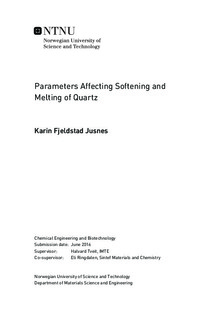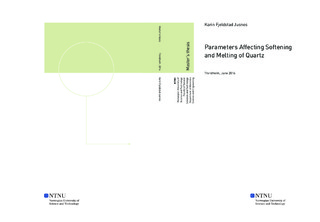| dc.description.abstract | The aim of this work was to develop and improve a new method for investigating how different parameters affect the softening and melting of quartz. The method should give quantitative results. Quartz is the stable phase of silica at room temperature, and is used as raw material for silicon production. When silica starts to soften and melt it can react with the surroundings in a furnace. This is undesirable too high in the furnace, because it can cause a more compact charge leading to decreased gas permeability. Softening of silica can also alter the reaction rates. A deeper understanding of the softening and melting properties of silica can lead to a more thorough selection of new raw materials and efficient furnace operations. Costs and energy consumptions can be decreased.
This study has focused on the following parameters effect on softening and heating: temperature, heating rate, quartz type, holding time and particle size. The method used for the investigation was based on the stationary charge in controlled environment (S.C.I.C.E) technique. Carbon crucibles were filled with quartz and silicon carbide, and then heated in an induction furnace. Temperature control was important, and therefore several experiments were performed to establish the uncertainty. After cooling, the crucibles were cut into two halves, so each surface could be studied and the areas of softened and melted silica measured.
The new method for investigating softening and melting properties of silica was adequate. Results from the experiments show that a more impure quartz type will soften and melt at a lower temperature than a purer type. Increasing the holding time at maximum temperature also causes the softening and melting to increase. The effect of particle size was inconsistent, but at higher temperature the softening and melting will increase with decreasing particle size. Increasing the heating rate also showed some inconsistent results. At higher temperature the difference was negligible. | |

